Abstract
The widespread use of single-use polypropylene packaging for sterilization of surgical instruments (blue wrap) results in enormous environmental pollution and plastic waste, estimated at 115 million kilograms on a yearly basis in the United States alone. Rigid sterilization containers (RSCs) are a well-known alternative in terms of quality and price. This paper deals with two research questions investigating the following aspects: (A) the environmental advantage of RCS for high volumes (5000 use cycles) in big hospitals, and (B) the environmental break-even point of use-cycles for small hospitals. An in-depth life cycle assessment was used to benchmark the two systems. As such a benchmark is influenced by the indicator system, three indicator systems were applied: (a) carbon footprint, (b) ReCiPe, and (c) eco-costs. The results are as follows: (1) the analyzed RSC has 85% less environmental impact in carbon footprint, 52% in ReCiPe, and 84.5% in eco-costs; and (2) an ecological advantage already occurs after 98, 228, and 67 out of 5000 use cycles, respectively. Given these two alternative packaging systems with comparable costs and quality, our results show that there are potentially large environmental gains to be made when RSC is preferred to blue wrap as a packaging system for sterile surgical instruments on a global scale.
1. Introduction
The healthcare sector is known to be a large contributor to environmental pollution. On average, 5.5% of the total national carbon footprint of countries is from the healthcare sector, with developed countries such as The Netherlands, the United States (US), Belgium, and Japan in the lead with 7.6 to 8.1% [1]. In 2013, the global disease burden due to the environmental impact of the U.S. healthcare sector was calculated to be 614,000 disability-adjusted life-years (DALY) annually [2]. This paradox of healthcare having indirect adverse effects on public health calls for action to improve the environmental performance of the healthcare sector by energy savings as well as pollution and waste reduction [3].
Being a very resource intensive part of the hospital, the operating room (OR) is an area where CO2 emission saving measures potentially have a large impact. The carbon footprint of the OR is primarily determined by the use of inhalation anesthetics; energy use by the heating, ventilation, and air conditioning (HVAC); supply chain; and waste production [4]. OR waste production is constantly growing, being partially explained by the increased use of disposable products in the last two decades. Disposables have replaced reusables and are nowadays the standard in healthcare. The rationale for this transition being infection prevention, cost reduction, and convenience. Many items that were once reusable in the OR have been replaced by disposable alternatives. Some examples are surgical gowns and drapes, laparoscopic instruments, and anesthetic equipment such as facemasks and breathing circuits. Discarding these disposables after use results in a considerable waste production that has become characteristic for the OR. In the meantime, a single operation generates an average of 12 kg of waste, causing the OR to be a major source of total hospital waste production [4].
Although recycling is frequently considered as the primary solution to reduce OR waste [5,6], it is often difficult in an operating room setting because of a lack of knowledge of recyclable materials and the fact that it often involves the handling of infectious materials [7]. Apart from these practical barriers to recycling, it is important to realize that the majority of packaging materials and disposable products used during operations are made of plastics and that recycling is actually downcycling of these products. In practice, recycled materials are rarely used as raw materials for similar products in the OR. Therefore, from an environmental perspective, it is better to reduce waste by first applying the other cornerstones for waste reduction “reduce”, “reuse”, and only then consider “recycle” [8]. Recycling is an important way to ensure that valuable raw materials are not wasted in a circular economy. However, first and foremost, prevention of waste being generated is the best way to improve the OR’s environmental impact [9,10]. Surgery has in this a distinct opportunity to aid the transition to more environmentally friendly operating room strategies [11].
The use of blue wrap as disposable packaging material for sterile surgical instruments is a major contributor to OR waste [7]. Estimates are that 115 million kilograms of blue wrap is discarded on a yearly basis in the United States alone [8]. Blue wrap is a multilayer non-woven packaging material made from polypropylene (PP) supplied as sheets. Surgical instrument nets are wrapped in the sheets, in a similar way as packages being wrapped (Figure 1). Through the manufacturing process of spun bonding and melt blowing, a unique PP trilaminate is produced that is characterized by robustness and bacterial resistance and that withstands high temperatures necessary for the sterilization process [12].
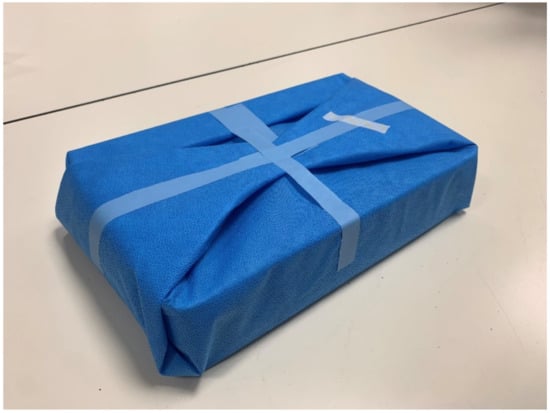
Figure 1.
The Halyard blue wrap.
After unpacking sterile surgical instruments, blue wrap packaging is discarded, making up 11.5% of total OR waste [6]. Reducing OR waste is possible by considering reusable alternatives for perioperative disposables. An alternative to blue wrap is a reusable rigid sterilization container (RSC) [13]. However, no compelling evidence exists for whether the quality of either of these packaging systems would be better than the other. RSCs are used by the majority (60%) of sterilization departments in Europe, but much less in North America, China, and India, where blue wrap is preferred [14]. The overall total costs of purchase and use of both packaging systems are comparable [15]. However, relatively large capital investments are required to purchase the containers, more storage space is needed, and the containers are ergonomically inferior because of their weight. These drawbacks of RSCs are a possible explanation for the worldwide popularity of blue wrap.
For a number of perioperative textiles, surgical instruments, and anesthetic devices, a life cycle assessment (LCA) has been done and has shown reusables to be environmentally favorable to disposables [16,17,18,19,20,21,22,23]. However, this effect may depend on the local situation, as was evident in a LCA study of single-use anesthetic equipment where the results depended considerably on the power mix in the region of research [24]. To this day, no LCA studies have been conducted to research the ecological burden of blue wrap or RCA.
For the present study, our hypothesis was that, in the European situation, the use of the reusable RSC has less environmental impact than single-use blue wrap, even when closed loop upcycling is applied. This hypothesis was tested by two research questions investigating the following aspects: (A) the environmental advantage of RCS for high volumes (5000 use cycles) in big hospitals, and (B) the environmental break-even point of use-cycles for small hospitals.
An in-depth life cycle assessment was used to benchmark the two systems, cradle-to-grave, as well as for cradle-to-cradle (“closed loop”) solutions. The influence of the power mix will be examined as well in order to see the effect of local renewable electricity (i.e., electricity with a ‘bundled’ renewable energy certificate) or electricity of other regions of the world.
2. Method: Life Cycle Assessment
2.1. The System and the Functional Unit
This study used the three-layered spunbond-meltblown-spunbond (SMS) one-step non-woven H300 model Quick Check Sterilization wrap 101 cm × 101 cm as a representation of blue wrap (Figure 1). As RSC, the standard container of B.Braun Medical B.V. with bottom model JK441 (59.2 × 27.4 × 12.0 cm) and lid model JP489 was chosen (Figure 2). Both the type of blue wrap and the brand of RSC were chosen on the basis of availability in our hospital (the Leiden University Medical Centre (LUMC) in The Netherlands). The sizes of both blue wrap and RSC were chosen to fit a standard format instrument tray (European Standard DIN: 480 × 250 × 60 mm).
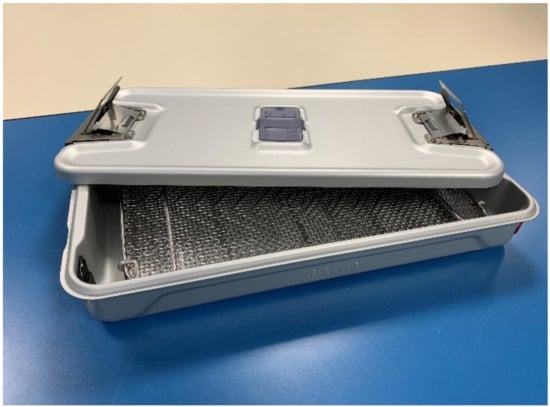
Figure 2.
The B.Braun RSC.
The scope of this research is a comparative cradle-to-grave LCA benchmarking study, which includes four phases during the product life: the production phase (includes the extraction of material, transport to the production site, and manufacturing), the transport phase (from production site to the hospital), the use phase (washing and sterilization process), and the end-of-life phase (incineration, landfill, and recycling). The processes included for the four systems under study are presented in the flow charts in Figure 3. Key data for the LCA of the Halyard sterilization wrap and the B.Braun RSC are shown Appendix A. The production of capital goods, such as washing machines and autoclaves, is excluded from the LCA.
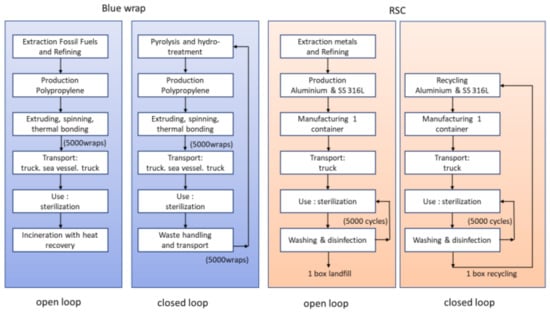
Figure 3.
Summary flow charts of the processes included in the four systems under study: Blue wrap open and closed loop and RSC open and closed loop.
The functional unit is defined as follows: sterile packaging of a standard format instrument tray for 5000 sterilization cycles. The RSC is validated for 5000 cleaning and sterilization cycles, using ten reusable filters (five times two filters, each usable for 1000 cleaning and sterilization cycles). This implies that 5000 Halyard H300 Quick Check Sterilization wraps are comparable to one RSC used 5000 times.
The material composition of both the blue wrap and RSC was determined using manufacturer information. For accuracy, each individual material of the RSC was weighted using a microgram scale. Data on electricity, water, and detergent usage of the washing machine were gathered from the manufacturer. Data on transportation were specific to our hospital in Leiden, the Netherlands. Alternative scenarios for recycling, power source use, and the RCA’s life span were considered to make the results applicable in a wider range of practical situations.
2.2. Choice of Single Indicators
LCA is used here to determine whether “system A is better than system B”, so-called “single score methods” are applied, as has been recommended by the Society of Environmental Toxicology and Chemistry [25] and the Joint Research Centre of the EU [26]. As the LCA scores depend on the choice of indicator system, the calculations were performed for three indicator types: (i) carbon footprint, as a “single issue method”; (ii) ReCiPe, as a “damage-based method”; and (iii) eco-costs, as a “monetized prevention-based method”. In their sectors, these three indicators are the most applied methods in science.
The carbon footprint is well known, but has the disadvantage that toxic emissions and materials’ depletion are not counted in the system. We apply the IPCC 2013 midpoint table (‘with climate-carbon feedback”). The ReCipe system, version 2016, has the advantage that toxicities and materials’ depletion are incorporated [27]. The disadvantages are that it is complex, not very transparent, and not easy to communicate the results to non-experts. We apply the ReCiPe 2016 Endpoint (H), World (2010) H/A.
The eco-costs is a system of marginal prevention costs that is in compliance with ISO 14008:2019 [28]. Although monetization in LCA is not very common, the advantage of eco-costs is that they are related to “external costs” (i.e., costs for our society that are not yet incorporated in the price of a product), so they have a direct meaning to decision takers, and are easy to communicate. Recently, there have been increasing applications of eco-costs in design and engineering, especially for innovations in the Circular Economy. Eco-costs are also applied in full cost accounting, which is also called true cost accounting (TCA). The basic philosophy behind TCA is that the external costs of a product should be added to the economic costs to enable a fair comparison in product benchmarking between a cheap but polluting product and a “clean” product.
The eco-costs of a product are the sum of all eco-costs of emissions and use of materials during the life cycle from “cradle to cradle”, in fact a mass and energy balance, conforming to ISO 14040 and ISO 14044 for LCAs [29]; see Figure 4.
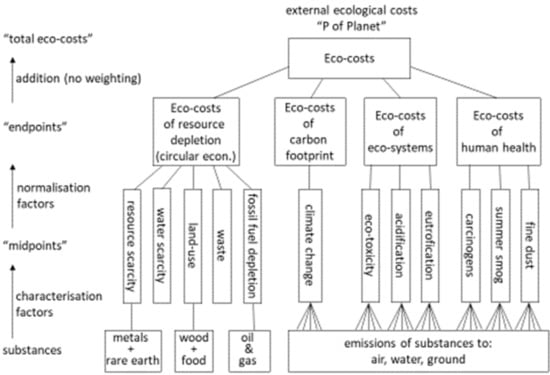
Figure 4.
The eco-costs system calculation structure [29].
The Delft University of Technology has calculated the LCA results in eco-costs for all 6600 useful LCI data lines of Ecoinvent V3.6 and, in addition to that, 1200 LCIs from scientific peer-reviewed papers and databases from other universities (on materials, processes, electricity, and heat), resulting in two data sets (EI_V3-6 and Idemat, respectively) with five Excel lookup tables [30]. This way of calculating with the use of a spreadsheet and open access background process databases is called Fast Track LCA. It makes it possible to compare the environmental burden of products in a limited time, with no need for company software or licenses, and without any compromise in terms of accuracy. The Idemat data as well as the eco-costs system are also available in Open LCA and can be downloaded for Simapro. The calculations of this paper were done in Simapro version 9.2.
For the hot-spot analysis in Appendix B, and the alternative scenarios for electricity in Section 3.3, we apply the eco-costs, as the eco-costs method is the preferred system in the discussions on the main system improvements in our hospital.
2.3. Modelling Parameters
For the composition of an RSC, the current trade mix aluminium is used (12.5% recycled). The fabric of blue wrap is known as SMS polypropylene. The production process involves extrusion, spinning, and melt blowing. Travel distances from the production site to the LUMC, The Netherlands, were estimated with Google Maps. All factors regarding the sterilization process were assumed to be equal as the dimensions of the instrument tray wrapped in blue wrap or placed in a RSC are similar, and thus the same number of trays can be loaded into a sterilization machine. A study of steam sterilization’s energy and water footprint [31] shows that the load mass of a steam sterilizer is low, but not negligible in regard to its energy consumption. Therefore, the amount of energy needed to heat the packaging material from 20 °C to 134 °C was taken into account in the use-phase of the LCA. The washing process for the RSC was taken into account as well in the use-phase, based on the PG8930 Miele washing machines.
For blue wrap, two end-of-life scenarios were calculated: (1) “open loop” waste incineration with heat recovery and (2) a future scenario of “closed loop” recycling [32]. For the RSC, the two end-of-life scenarios were calculated as follows: (1) landfill and (2) recycling of the metals.
2.4. Three Scenarios for Electricity
Electricity is an important determinant for the environmental impact in the use phase of sterilization and washing. Three scenarios for the electrical power supply were tested: (1) the current electricity mix in the European Union, i.e., the base case; (2) 100% photovoltaic (PV) cells for the European climate condition; and (3) 100% coal-fired power plants (the average in the USA, China, and Europe).
3. Results
3.1. The Environmental Gain for 5000 Cycles (Research Question A)
The results from the three indicator systems (carbon footprint, ReCiPe, and eco-costs) for 5000 use cycles of both packaging systems (blue wrap and RSC) are shown in Figure 5a–c.
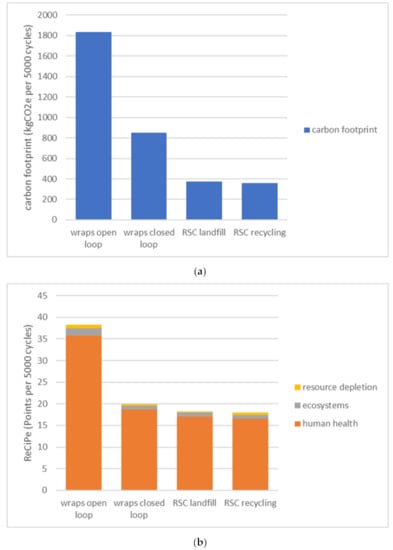
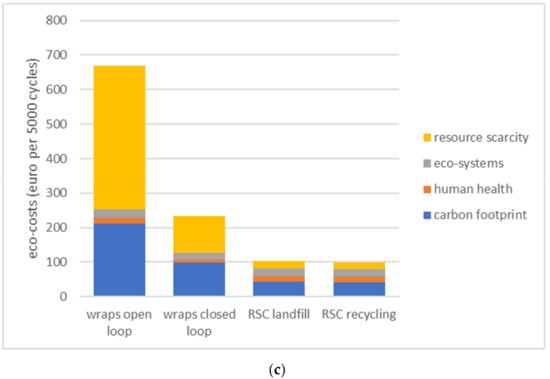
Figure 5.
(a) The carbon footprint of blue wrap and the RSC for 5000 cycles. (b) The ReCiPe points of blue wrap and the RSC for 5000 cycles. (c) The eco-costs of the wraps and the RSC for 5000 cycles.
In Figure 5a, the carbon footprint scores of blue wrap and the RSC are given for two scenarios: the current open loop situation and the future closed loop recycling. The current open loop situation gives by far the highest carbon footprint: 1869 kg CO2e/5000 cycles. That carbon footprint can significantly be reduced by a closed loop system with mechanical recycling of the PP (shredding and melting): 883 kg CO2e/5000 cycles. As mechanical recycling is downcycling (the quality of the PP deteriorates at each recycling loop), 10% virgin PP is added at the manufacturing plant. The RSC has the lowest carbon footprint of 285 kg CO2e/5000 cycles for landfill and 270 kg CO2e/5000 cycles for recycling. Closed loop scores hardly lower than the current open loop recycling in Western Europe. The reason for the small difference is that the RSC 5000 cycle case is dominated by the use-phase (i.e., washing and sterilization). See Table A5 in Appendix B.
The results in terms of ReCiPe points are given in Figure 5b. ReCiPe is about damage in terms of human health, ecosystems, and resource depletion, and has no separate score for global warming. However, the toxicity of the carbon footprint (kgCO2e) is rather dominant in human health. The reasoning is that global warming, i.e., higher temperatures, results in more diseases, and thus more DALYs.
For blue wrap (open loop), the CO2e component in human health in our calculations is 79%. That is the main reason that the ReCiPe results look similar to the results of the carbon footprint. It should be mentioned here that the uncertainty in these damage-based calculations on CO2 is rather high, because of the many calculation steps in the required calculations, and the many assumptions. This is in contrast to the prevention-based eco-costs of CO2.
For RSC (recycling), the CO2e component in human health is only 34%. The other main components are 31% for fine dust, 30% for the human health effect of water scarcity (caused by the rather high water consumption of the washing machine in the use phase), and 5% for human toxicity.
Another issue in ReCiPe is that resource depletion (e.g, the fossil fuels embedded in plastics) hardly counts in the system. Thus, the plastic waste mentioned in the Introduction is barely counted in ReCiPe.
It appeared in our research project that the eco-costs system provided the best basis for the analysis and communication. The calculation results are given in Figure 5c. Characteristic for the eco-costs system is that materials’ scarcity has a relative high share of the total eco-costs of plastics (as well as metals), which makes eco-costs suitable for C2C calculations in the circular economy. Detailed data tables (per process step) for hot spot analyses are given in Appendix B.
From Figure 5a–c, it may be concluded that (a) the RSC system has much lower environmental pollution than the blue wrap system and (b) the pollution of the blue wrap system can be reduced to 50% or less when a closed loop recycling system is introduced.
It is obvious that these conclusions depend on the number of cycles as defined by the functional unit (the RSC becomes less attractive at less cycles). Thus, it makes sense to calculate the break-even point for both systems (blue wrap and RSC), which is relevant for small hospitals.
3.2. The Break-Even Points of Both Packaging Systems (Research Question B)
The potential environmental gain by the switch from a blue wrap system to a RSC system, which has been calculated in the previous section, is interesting to big hospitals. Small hospitals might have a far lower functional unit than 5000 cycles. For these small hospitals, the break-even point of number of cycles is interesting (the question is, at how many cycles does the RSC have the same environmental burden as the blue wrap system?). The answer to this question (our research question B) is depicted at Figure 6a–c for carbon footprint, ReCiPe points, and eco-costs, respectively. The data were calculated for specific scenarios for end-of-life: the wraps are incinerated with heat recovery and the RSCs are landfilled.
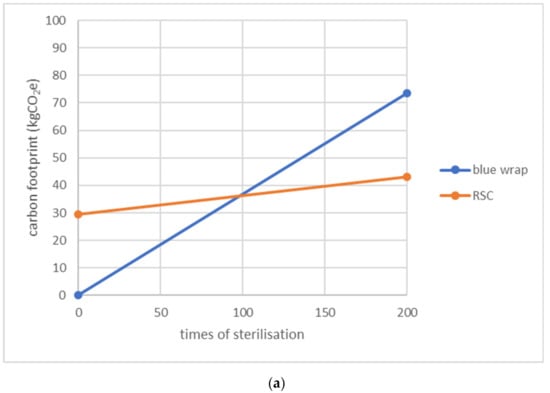
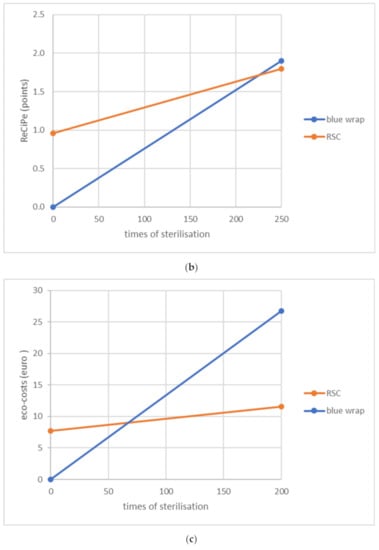
Figure 6.
(a) Break-even analysis of blue wrap (open loop recycling) and RSC (landfill) for the carbon footprint. (b) Break-even analysis of blue wrap (open loop recycling) and RSC (landfill) for ReCiPe. (c) Break-even analysis of blue wrap (open loop recycling) and RSC (landfill) for eco-costs.
For waste incineration with heat recovery (‘open loop’) and landfill of the RSCs (Figure 6a–c), the break-even points are as follows: 98 cycles for the carbon footprint, 228 cycles for ReCiPe, and 67 cycles for eco-costs.
It is obvious that the break-even points are higher for the case of recycling of the wraps (closed loop mechanical recycling), as the eco-burden of the mechanical recycled wraps is much lower than the eco-burden of wraps from virgin PP. The results of the calculations are as follows: 150 cycles for the carbon footprint, 1293 cycles for ReCiPe, and 88 cycles for eco-costs.
Note that, in ReCiPe, the eco-burden of the closed loop blue wrap system (5000 cycles) is not much higher than the eco-burden of the RSC system; see Figure 5b. Hence the high break-even point in ReCiPe.
3.3. Alternative Scenarios for Electricity of the Use-Phase (Sterilization and Washing)
The major component of the RSC system is the power consumption in the use-phase at the hospital: 1996 MJ per 5000 cycles; see Table A5 and Table A6 in Appendix B. This triggers the discussion on the potential positive environmental effect of PV cells on the roof of the hospital. The positive effect in terms of eco-costs is given in Figure 7. This figure also gives information for electricity in countries outside the EU.
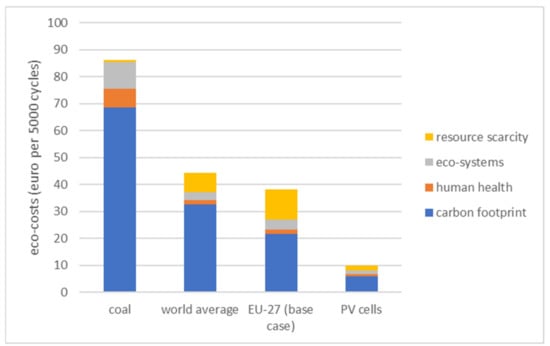
Figure 7.
Alternative power source scenarios for the use-phase of the RSC system (i.e., power for the sterilization and the washing machine).
Compared with the electricity mix in EU-27 (the base case), there is a potential reduction in the eco-cost of the RSC system of 28 euro per 5000 cycles (−74%) when electricity from local PV cells is used.
Note that the electricity in the use-phase for blue wrap is rather negligible: 103 MJ per 5000 cycles; see Table A3 in Appendix B.
4. Discussion
Disposable blue wrap is a very popular surgical instrument sterilization packaging system that is used by many sterilization departments in Europe, North America, China, and India. However, its use causes a great deal of healthcare waste and does not match the goal of a circular economy. In this context, it was hypothesized that choosing a reusable packaging system would be environmentally preferable.
This is the first peer-reviewed research into the environmental impact of RSCs and blue wrap. An LCA benchmarking study of these two packaging systems was executed. The main result of our study is that, in the European situation, an aluminum RSC, as a packaging system for surgical instrument sterilization, has 84% less eco-costs compared with the current three-layered, one-step, non-woven polypropylene blue wrap for a functional unit of 5000 cycles (which is the answer to our research question A). The advantage in eco-costs for the RSC already occurs after 68 out of 5000 use cycles (which is the answer to our research question B). The production phase of blue wrap is the main contributor to its eco-costs (88%), primarily owing to the PP pellets. For the RSC, the use phase (washing and sterilization) causes 93% of its eco-costs, primarily owing to the detergents and electricity usage.
In the context of regional differences in the energy mix of washing and sterilization, we modeled the effects on our results of switching to electricity generated exclusively by renewable energy sources or by bitumous coal power plants. This had hardly any influence on the results of blue wrap and only a moderate influence on those of the RSC (see Figure 7 and Table A6 in Appendix B).
As an alternative to switching to the RSC system, we studied the impact of closed loop mechanical recycling instead of incineration of blue wrap as an end-of-life scenario. Modelling closed-loop polypropylene recycling reduced blue wrap eco-costs to 35%. However, in this scenario, the RSC still outperformed blue wrap ecologically by more than a factor of two.
The choice of a packaging system for sterile instruments may depend on many factors. Financial arguments may be important in this regard. For example, the RSC system requires upfront investment in washing and sterilization machines in addition to the purchase of the containers. The purchase of blue wrap is relatively inexpensive in this regard. However, Krohn et al. have shown that the total costs of ownership of these two systems are quite similar over time [15]. They conclude that a choice for a particular system may then depend on the availability of financial resources for the necessary investments or that time savings in container handling may be a motive if there are personnel shortages. From a patient safety perspective, according to the guidelines, both systems are suitable as packaging for sterile instruments [33]. However, a concern is the fragility of blue wrap, which, if damaged, may violate the sterile barrier [34,35]. This is the reason that containers are preferred in some cases such as when heavy orthopedic instruments are concerned.
Thus, switching from blue wrap to RSC may have financial and practical consequences. If this is not desirable or the time is not yet ripe, a choice can be made to recycle blue wrap. However, recycling medical plastics is challenging as separation in the workplace is difficult and there is the danger of potential infection hazards [7]. In the case of blue wrap, it is technically possible to reuse the recycled polypropylene as a raw material. Moreover, the risk of infection is low because blue wrap can be collected cleanly before the surgery [12]. However, contamination of the product in the sense of tape and the presence of chemical indicators must be taken into account.
Limitations due to modeling uncertainty and constraints are inherent to every LCA. The functional unit, impact indicator, and databases may each have an effect on the impact assessment. All data used from the Idemat (EcoInvent) databases are modeled and present limitations. The measures of impact found in different databases are generally comparable, though differences of 30% are possible. The eco-cost indicator is advantageous because it allows relatively easy and transparent calculations, there is no need for panel weighting of each impact category, and the results can be explained in terms of costs and measures to be taken.
We did not measure water and energy consumption, but calculated these from the manufacturer’s information. Moreover, estimates were made about the modes of transportation and, for certain production processes, alternatives were chosen because they were not available in the database registers. None of these are expected to have a significant influence on the final results. With regard to the water and energy consumption, even a doubling of the eco-costs of the use phase of the RSC would not alter the conclusions drawn. The transport phase of both RSC and blue wrap is a relatively small part of the eco-costs (0.2 and 5%, respectively), which makes it unlikely that alternate assumptions would suddenly dominate the results.
Only three-layered, one-step, non-woven polypropylene wrap and RSCs made of aluminum were included in our study, as these are the two most widely used systems in the world. However, there are other packaging materials available for surgical instrument sterilization that may show different results; for example, other multilayer non-wovens, paper, cotton, and mold bush drums. The latter two are mainly still used in developing countries, as they do not meet the ISO standard (11607) for sterilization packaging materials.
Future research should be directed at executing more LCAs of disposable items found in the OR, as they are known to be a significant contributor to its carbon footprint [4]. Much research that has been done on the carbon footprint of the OR has focused on the effects of inhalation anesthetics, HVAC, and waste production. A small number of LCA studies have already been done [16,17,18,19,20,21,22,23], but for many disposable items in the OR, the answer to the question regarding the environmental impact has not yet been given.
5. Conclusions
This study shows that the use of a rigid sterilization container has 84% less eco-costs than when blue wrap is used to package surgical instruments for sterilization. This difference is of such an order of magnitude that the container is more environmentally friendly after only 68 of the 5000 use-cycles.
When the choice of blue wrap as a packing system is made, recycling blue wrap is an option. In the closed loop recycling scenario, with all three single indicators, there was a halving of the pollution from the blue wrap system compared with the cradle-to-grace system.
The widespread use of disposable blue wrap packaging in developed countries is an example of health care pollution that could be reduced by opting for reusable sterilization containers. With a healthcare system that is co-responsible for the impact of pollution on public health, it is the role of doctors and healthcare managers to point out the need for a transition to circular management in their industry [36]. Our results show ecological benefits that must be included in the decision making process of procurement.
Doctors should be conscious of how encultured disposables like blue wrap have become in healthcare. Often, unrealistic expectations regarding infection prevention, perceived price benefit, and ease of use underlie the choice for disposables [37]. We need to be more informed of the destructive effects of our disposables on the environment and demonstrate which alternatives exist on the basis of LCA-driven scientific research. Our reliance on healthcare disposables has resulted in excessive wastage and pollution and has exposed us to supply chain vulnerability, as the current COVID-19 crisis has made painfully clear.
Author Contributions
Conceptualization, H.J.F.; methodology, H.J.F. and J.G.V.; software, C.W.v.E. and J.G.V.; investigation, C.W.v.E.; writing—original draft preparation, H.J.F.; writing—review and editing, J.G.V., A.C.v.d.E. and F.W.J.; visualization, H.J.F., C.W.v.E. and J.G.V.; supervision, A.C.v.d.E. and F.W.J. All authors have read and agreed to the published version of the manuscript.
Funding
This research received no external funding.
Data Availability Statement
The data presented in this study are available on request from the corresponding author.
Conflicts of Interest
The authors declare no conflict of interest.
Appendix A. Key Data for LCA
Blue wrap (Halyard H300 Quickcheck wrap)
- − declared unit: 5000 blue wraps
- − transport: production site in Lexington, North Carolina, USA; use phase in Leiden, The Netherlands
- − open loop (cradle-to-grave): end-of-life is municipal waste incineration (in the region of the hospital)
- − closed loop (cradle-to-cradle): upcycled at the production location, transport back to North Carolina
- − weight of 5000 wraps: 457 kg
B.Braun Medical container (model JK441 + JP489)
- − declared unit: 1 container, lifespan 5000 sterilization cycles
- − transport: production site in Tuttlinge, Germany; use phase in Leiden, The Netherlands
- − open loop (cradle to grave): end-of life is land fill
- − closed loop (cradle-to-cradle): upcycling
- − total weight of 1 box: 3.41 kg (AL 2.63 kg, SS 316L 0.49 kg, PTFE 0.24 kg, PDMS 0.05 kg)
Appendix B. Tables for Hot-Spot Analyses in Eco-Costs

Table A1.
Five thousand blue wrap ‘open loop’, cradle-to-grave, and has ‘production’ as hot-spot.
Table A1.
Five thousand blue wrap ‘open loop’, cradle-to-grave, and has ‘production’ as hot-spot.
| Cradle-to-Grave 5000 Blue Wraps ‘Open Loop’ | Total | Climate Change | Human Health | Eco-Systems | Resource Depletion |
|---|---|---|---|---|---|
| production | 590.09 | 136.75 | 19.71 | 27.54 | 406.09 |
| transport | 25.59 | 10.15 | 0.87 | 3.19 | 11.38 |
| use-phase | 1.97 | 1.12 | 0.08 | 0.20 | 0.58 |
| end-of-life incineration | 51.46 | 64.87 | −5.16 | −7.20 | −1.04 |
| total | 669.11 | 212.88 | 15.50 | 23.73 | 417.00 |

Table A2.
Five thousand blue wraps, open loop, production, and has ‘‘PP (polypropylene)’ as hot-spot.
Table A2.
Five thousand blue wraps, open loop, production, and has ‘‘PP (polypropylene)’ as hot-spot.
| Hotspot ‘Production’ 5000 Blue Wrap ‘Open Loop’ | Total | Climate Change | Human Health | Eco-Systems | Resource Depletion |
|---|---|---|---|---|---|
| PP (polypropylene), 456.85 kg | 485.69 | 86.61 | 16.03 | 17.31 | 365.75 |
| extrusion, 456.85 kg | 9.10 | 6.73 | 0.29 | 0.64 | 1.44 |
| spinning first layer, 152.28 kg | 21.54 | 15.92 | 0.69 | 1.52 | 3.41 |
| thermo forming, 152.28 kg | 5.34 | 3.95 | 0.17 | 0.38 | 0.85 |
| spinning 2nd layer, 152.28 kg | 21.54 | 15.92 | 0.69 | 1.52 | 3.41 |
| Pigments, 14.13 kg | 46.89 | 7.64 | 1.85 | 6.17 | 31.24 |
| total | 590.09 | 136.75 | 19.71 | 27.54 | 406.09 |

Table A3.
Five thousand blue wraps ‘closed loop’, cradle-to-cradle, and has ‘production’ as hot-spot.
Table A3.
Five thousand blue wraps ‘closed loop’, cradle-to-cradle, and has ‘production’ as hot-spot.
| Cradle-to-Cradle 5000 Blue Wrap ‘Closed Loop’ | Total | Climate Change | Human Health | Eco-Systems | Resource Depletion |
|---|---|---|---|---|---|
| production | 179.54 | 77.10 | 6.19 | 13.86 | 82.38 |
| transport | 25.59 | 10.15 | 0.87 | 3.19 | 11.38 |
| use-phase | 1.97 | 1.12 | 0.08 | 0.20 | 0.58 |
| end-of-life return | 25.59 | 10.15 | 0.87 | 3.19 | 11.38 |
| total | 232.68 | 98.51 | 8.01 | 20.44 | 105.72 |

Table A4.
Five thousand blue wraps, closed loop, production, and has ‘PP (polypropylene)’ as hot-spot.
Table A4.
Five thousand blue wraps, closed loop, production, and has ‘PP (polypropylene)’ as hot-spot.
| Hotspot ‘Production’ 5000 Blue Wraps ‘Closed Loop’ | Total | Climate Change | Human Health | Eco-Systems | Resource Depletion |
|---|---|---|---|---|---|
| mechanical rec. PP, 411.17 kg | 26.57 | 18.30 | 0.91 | 1.89 | 5.47 |
| extrusion, 456.85 kg | 9.10 | 6.73 | 0.29 | 0.64 | 1.44 |
| spinning first layer, 152.28 kg | 21.54 | 15.92 | 0.69 | 1.52 | 3.41 |
| thermo forming, 152.28 kg | 5.34 | 3.95 | 0.17 | 0.38 | 0.85 |
| spinning 2nd layer, 152.28 kg | 21.54 | 15.92 | 0.69 | 1.52 | 3.41 |
| Pigments, 14.13 kg | 46.89 | 7.64 | 1.85 | 6.17 | 31.24 |
| PP (olypropylene), 45.68 kg | 48.56 | 8.66 | 1.60 | 1.73 | 36.57 |
| total | 179.54 | 77.10 | 6.19 | 13.86 | 82.38 |

Table A5.
RSC B.Braun, 5000 cycles ‘open loop’ landfill, and has the use-phase as hot-spot.
Table A5.
RSC B.Braun, 5000 cycles ‘open loop’ landfill, and has the use-phase as hot-spot.
| RSC B.Braun ‘Open Loop’ (Landfill) | Total | Climate Change | Human Health | Eco-Systems | Resource Depletion |
|---|---|---|---|---|---|
| production | 7.58 | 3.35 | 0.23 | 0.97 | 3.04 |
| transport | 0.12 | 0.05 | 0.01 | 0.01 | 0.06 |
| use phase | 96.31 | 39.92 | 16.01 | 22.22 | 18.16 |
| end-of-life landfill | 0.00 | 0.00 | 0.00 | 0.00 | 0.00 |
| total | 104.02 | 43.32 | 16.25 | 23.20 | 21.26 |

Table A6.
RSC B.Braun, 5000 cycles, and the use-phase has electricity as hot-spot.
Table A6.
RSC B.Braun, 5000 cycles, and the use-phase has electricity as hot-spot.
| RSC B.Braun Hotspot ‘Use Phase’ | Total | Climate Change | Human Health | Eco-Systems | Resource Depletion |
|---|---|---|---|---|---|
| ultrapure water, 5312.5 kg | 10.37 | 1.84 | 1.10 | 6.46 | 0.97 |
| deionised water, 115625 kg | 15.93 | 5.90 | 3.31 | 3.86 | 2.86 |
| xHelematic cleaner, 106.25 kg | 31.80 | 10.44 | 10.15 | 8.05 | 3.16 |
| electricity EU-27, 1996 MJ | 38.21 | 21.74 | 1.46 | 3.85 | 11.17 |
| total | 96.31 | 39.92 | 16.01 | 22.22 | 18.16 |
Note: all process steps with estimated eco-costs of less than 0.5% of the total eco-costs were neglected.
References
- Pichler, P.P.; Jaccard, I.S.; Weisz, U.; Weisz, H. International comparison of health care carbon footprints. Environ. Res. Lett. 2019, 14, 064004. [Google Scholar] [CrossRef] [Green Version]
- Eckelman, M.J.; Sherman, J.D. Estimated Global Disease Burden From US Health Care Sector Greenhouse Gas Emissions. Am. J. Public Health 2018, 108, S120–S122. [Google Scholar] [CrossRef] [PubMed]
- Eckelman, M.J.; Sherman, J. Environmental Impacts of the US. Health Care System and Effects on Public Health. PLoS ONE 2016, 11, e0157014. [Google Scholar] [CrossRef] [Green Version]
- MacNeill, A.J.; Lillywhite, R.; Brown, C.J. The impact of surgery on global climate: A carbon footprinting study of operating theatres in three health systems. Lancet Planet Health 2017, 1, e381–e388. [Google Scholar] [CrossRef] [Green Version]
- McGain, E.; Hendel, S.A.; Story, D.A. An audit of potentially recyclable waste from anaesthetic practice. Anaesth. Intensive Care 2009, 37, 820–823. [Google Scholar] [CrossRef] [Green Version]
- McGain, F.; Jarosz, K.M.; Nguyen, M.N.; Bates, S.; O’Shea, C.J. Auditing Operating Room Recycling: A Management Case Report. A A Case Rep. 2015, 5, 47–50. [Google Scholar] [CrossRef] [PubMed]
- Azouz, S.; Boyll, P.; Swanson, M.; Castel, N.; Maffi, T.; Rebecca, A.M. Managing barriers to recycling in the operating room. Am. J. Surg. 2019, 217, 634–638. [Google Scholar] [CrossRef]
- Kagoma, Y.; Stall, N.; Rubinstein, E.; Naudie, D. People, planet and profits: The case for greening operating rooms. CMAJ 2012, 184, 1905–1911. [Google Scholar] [CrossRef] [PubMed] [Green Version]
- Wyssusek, K.H.; Keys, M.T.; van Zundert, A.A.J. Operating room greening initiatives—The old, the new, and the way forward: A narrative review. Waste Manag. Res. 2019, 37, 3–19. [Google Scholar] [CrossRef]
- Sustainable Healthcare Waste Management in the EU Circular Economy Model. Available online: https://noharm-europe.org/documents/sustainable-healthcare-waste-management-eu-circular-economy-model (accessed on 30 December 2021).
- Guetter, C.R.; Williams, B.J.; Slama, E.; Arrington, A.; Henry, M.C.; Moller, M.G.; Tuttle-Newhall, J.E.; Stein, S.; Crandall, M. Greening the operating room. Am. J. Surg. 2018, 216, 683–688. [Google Scholar] [CrossRef]
- Joseph, B.; James, J.; Kalarikkal, N.; Thomas, S. Recycling of medical plastics. Adv. Ind. Eng. Polym. Res. 2021, 4, 199–208. [Google Scholar] [CrossRef]
- Rigid Sterilization Containers in the OR. Available online: https://practicegreenhealth.org/sites/default/files/upload-files/gorimpmod-rigidsterilcont_r5_web_0.pdf (accessed on 30 December 2021).
- Single-Use Sterilization Wraps Market: Global Industry Analysis 2013–2017 and Opportunity Assessment 2018–2028. Available online: https://www.futuremarketinsights.com/reports/single-use-sterilization-wraps-market (accessed on 9 June 2020).
- Krohn, M.; Fengler, J.; Mickley, T.; Flessa, S. Analysis of processes and costs of alternative packaging options of sterile goods in hospitals—A case study in two German hospitals. Health Econ. Rev. 2019, 9, 1. [Google Scholar] [CrossRef] [PubMed] [Green Version]
- Overcash, M. A comparison of reusable and disposable perioperative textiles: Sustainability state-of-the-art 2012. Anesth. Analg. 2012, 114, 1055–1066. [Google Scholar] [CrossRef] [PubMed]
- Vozzola, E.; Overcash, M.; Griffing, E. Environmental considerations in the selection of isolation gowns: A life cycle assessment of reusable and disposable alternatives. Am. J. Infect. Control 2018, 46, 881–886. [Google Scholar] [CrossRef] [Green Version]
- Vozzola, E.; Overcash, M.; Griffing, E. An Environmental Analysis of Reusable and Disposable Surgical Gowns. AORN J. 2020, 111, 315–325. [Google Scholar] [CrossRef]
- Ibbotson, S.; Dettmer, T.; Kara, S.; Herrmann, C. Eco-efficiency of disposable and reusable surgical instruments—A scissors case. Int. J. Life Cycle Assess. 2013, 18, 1137–1148. [Google Scholar] [CrossRef]
- McGain, F.; McAlister, S.; McGavin, A.; Story, D. The financial and environmental costs of reusable and single-use plastic anaesthetic drug trays. Anaesth. Intensive Care 2010, 38, 538–544. [Google Scholar] [CrossRef] [Green Version]
- McGain, F.; McAlister, S.; McGavin, A.; Story, D. A life cycle assessment of reusable and single-use central venous catheter insertion kits. Anesth. Analg. 2012, 114, 1073–1080. [Google Scholar] [CrossRef]
- Eckelman, M.; Mosher, M.; Gonzalez, A.; Sherman, J. Comparative life cycle assessment of disposable and reusable laryngeal mask airways. Anesth. Analg. 2012, 114, 1067–1072. [Google Scholar] [CrossRef]
- Sherman, J.D.; Raibley, L.A.t.; Eckelman, M.J. Life Cycle Assessment and Costing Methods for Device Procurement: Comparing Reusable and Single-Use Disposable Laryngoscopes. Anesth. Analg. 2018, 127, 434–443. [Google Scholar] [CrossRef]
- Olindo, R.; Schmitt, N.; Vogtländer, J. Life Cycle Assessments on Battery Electric Vehicles and Electrolytic Hydrogen: The Need for Calculation Rules and Better Databases on Electricity. Sustainability 2021, 13, 5250. [Google Scholar] [CrossRef]
- Kägi, T.; Dinkel, F.; Frischknecht, R.; Humbert, S.; Lindberg, J.; Mester, S.; Ponsioen, T.; Sala, S.; Schenker, U. Session “Midpoint, endpoint or single score for decision-making?”—SETAC Europe 25th Annual Meeting, May 5th, 2015. Int. J. Life Cycle Assess. 2015, 21, 129–132. [Google Scholar] [CrossRef]
- Sala, S.; Cerutti, A.; Pant, R. Development of a weighting approach for the Environmental Footprint; EUR 28562 EN; Publications Office of the European Union: Luxembourg, 2017. [Google Scholar] [CrossRef]
- Huijbregts, M.A.J.; Steinmann, Z.J.N.; Elshout, P.M.F.; Stam, G.; Verones, F.; Vieira, M.; Zijp, M.; Hollander, A.; van Zelm, R. ReCiPe2016: A harmonised life cycle impact assessment method at midpoint and endpoint level. Int. J. Life Cycle Assess. 2017, 22, 138–147. [Google Scholar] [CrossRef]
- ISO 14008:2019; Monetary Valuation of Environmental Impacts and Related Environmental Aspects; International Organization for Standardization: Geneva, Switzerland. 2019. Available online: https://www.iso.org/standard/43243.html (accessed on 2 November 2021).
- Vogtländer, J.G. A Practical Guide to LCA for Students Designers and Business Managers: Cradle-to-Grave and Cradle-to-Cradle, 5th ed.; Delft Academic Press: Delft, The Netherlands, 2017. [Google Scholar]
- The Model of the Eco-Costs/Value Ratio (EVR). Available online: https://www.ecocostsvalue.com/index.html (accessed on 26 May 2020).
- McGain, F.; Moore, G.; Black, J. Steam sterilisation’s energy and water footprint. Aust. Health Rev. 2017, 41, 26–32. [Google Scholar] [CrossRef]
- Babu, M.A.; Dalenberg, A.K.; Goodsell, G.; Holloway, A.B.; Belau, M.M.; Link, M.J. Greening the Operating Room: Results of a Scalable Initiative to Reduce Waste and Recover Supply Costs. Neurosurgery 2019, 85, 432–437. [Google Scholar] [CrossRef] [PubMed]
- Link, T. Guidelines in Practice: Sterilization Packaging Systems. AORN J. 2020, 112, 248–260. [Google Scholar] [CrossRef]
- Waked, W.R.; Simpson, A.K.; Miller, C.P.; Magit, D.P.; Grauer, J.N. Sterilization Wrap Inspections Do Not Adequately Evaluate Instrument Sterility. Clin. Orthop. Relat. Res. 2007, 462, 207–211. [Google Scholar] [CrossRef]
- Rashidifard, C.H.; Mayassi, H.A.; Bush, C.M.; Opalacz, B.M.; Richardson, M.W.; Muccino, P.M.; DiPasquale, T.G. Looking for Holes in Sterile Wrapping: How Accurate Are We? Clin. Orthop. Relat. Res. 2018, 476, 1076–1080. [Google Scholar] [CrossRef]
- Solomon, C.G.; LaRocque, R.C. Climate Change—A Health Emergency. N. Engl. J. Med. 2019, 380, 209–211. [Google Scholar] [CrossRef]
- Sherman, J.D.; Hopf, H.W. Balancing Infection Control and Environmental Protection as a Matter of Patient Safety: The Case of Laryngoscope Handles. Anesth. Analg. 2018, 127, 576–579. [Google Scholar] [CrossRef] [PubMed]
Publisher’s Note: MDPI stays neutral with regard to jurisdictional claims in published maps and institutional affiliations. |
© 2021 by the authors. Licensee MDPI, Basel, Switzerland. This article is an open access article distributed under the terms and conditions of the Creative Commons Attribution (CC BY) license (https://creativecommons.org/licenses/by/4.0/).